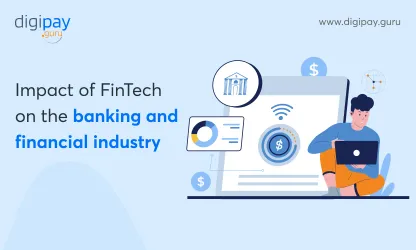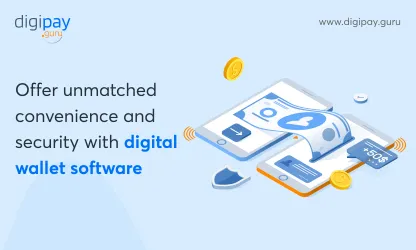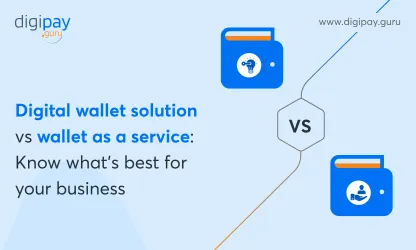Cash is not the ‘King’ anymore! The digital advent of payments has entirely changed the scenario and has given rise to cashless payments.
The first move towards cashless payment was a credit card in the 90s. In the same decade, the electronic banking system became common. And after that, the innovations in cashless payments continued.
Big names like PayPal and Apple Pay came into the picture. And today, no one wants to carry cash. Everyone wants to reap the benefits of cashless payments. However, cash still has its significance in many places but the world is gradually moving towards cashless payments.
The latest study by Statista shows a rise in the number of cashless transactions globally. By 2027 the global number of cashless transactions will reach 2297 billion. The above stats show an exponential increase in cashless transactions.

In this blog, you will discover:
- What cashless payments are
- The key types of cashless payments
- Benefits of adopting cashless payments, and
- Examples from various countries
What are cashless payments?
Cashless payments are transactions conducted electronically, without physical currency such as coins or banknotes. These transactions rely on various digital or electronic methods to transfer funds from one party to another.
In simple terms, cashless payments are “payments done without cash”. Today, there are so many types of cashless payments in the market.
- The US leads in card usage with debit cards being the most popular. 53% use a physical or virtual debit card and 37% use a physical or virtual credit card.
- China dominates digital wallet payments holding a 65% market share.
Key types of cashless payments
The major types of cashless payments are:

Credit/debit cards
Credit and debit cards have been one of the most convenient modes of cashless payments. Rather than paying in cash for goods and services, the user can use a credit or debit card to make payments.
This can be done in person, by card swiping or inserting the card in the card reader, or it can be done online, by adding the card details to the website/app’s payment page.
The most popular credit and debit cards are Visa and MasterCard.
Mobile wallet apps
Mobile wallet applications are gaining popularity due to their quick, secure, and convenient cashless payment options. Users can digitally store and manage credit, debit, and other payment cards. These apps allow users to send, receive, and store money, as well as manage loyalty rewards and coupons.
Users can link their bank accounts to add funds and send money via phone numbers, email IDs, or unique IDs. Additionally, they can make merchant payments and pay utility bills directly from the app. Popular examples include Apple Pay, Google Pay, and Samsung Pay.
Mobile banking apps
With a mobile banking app, you can check your account balances, pay bills, transfer money, and perform much more banking activities from your mobile device.
This cashless mobile payment eliminates the need to visit a bank branch or ATM in person, making it easier for users to manage finances on the go.
Mobile banking apps also include features like person-to-person (P2P) payments, which allow users to send money to a friend or family member directly from their mobile device. This can be a convenient alternative to using cash or checks for small transactions.
In addition, some mobile banking apps allow you to make purchases or payments to merchants that accept mobile payments, thereby reducing the need for cash. Today, almost every bank has mobile banking apps across the globe.
Virtual cards
Virtual cards, also called digital cards or virtual payment cards allow you to make online purchases or payments without using a physical card.
Instead of using a physical card, you can use a virtual card by providing the card information, such as the card number, expiration date, and security code, during the checkout process. It’s generally used via NFC-enabled mobile devices.
The major benefits of virtual cards are that they offer a convenient and secure way to make payments online and help reduce the need for cash. This promotes a cashless society.
QR code payments
QR code payments are one of the most popular modes of cashless payment. It uses QR codes to facilitate transactions.
A QR Code is a two-dimensional code with a pattern of black squares arranged on a square grid. This code can be scanned with a smartphone or other device to access information or make a payment.
QR codes are widely used for making cashless payments. Here, a user just has to scan the QR code of the merchant service to complete the transaction. Today, QR codes are almost everywhere.
Read more: The omnipresence of QR codes in the digital payment industry
NFC payments
NFC, or Near Field Communication, is a technology that allows users to make payments to devices in close proximity of a few centimeters. NFC can be used for contactless payments, ticketing, access control, and more.
With NFC payments, a user can simply tap his phone or other NFC-enabled mobile phones against a point of sale (POS) terminal to make a payment. This eliminates the need for cash or physical card payments.
NFC payments are becoming increasingly popular and accepted by numerous merchants, making it easier for customers to use this payment method.
In addition, NFC payments can offer an additional layer of security, as they are encrypted and require a secure connection to process the transaction.
Users can make payments via NFC-enabled phones at various places such as:
Read more: Know all about NFC payments
USSD
Unstructured Supplementary Service Data (USSD) is a cashless payment for those who don’t have a smartphone or proper access to traditional banking services in their location. The USP of this method is that the user can make payments without a smartphone or internet.
- USSD can be used by dialing *99# to initiate a financial transaction.
- When a user dials this code, he reaches an interactive voice menu via mobile phone.
- The transaction is then completed by following the prompts sent back via USSD.
However, to use this service, the user must ensure that his mobile number is linked to the bank account.
With the help of USSD, users can;
- Make payments
- Transfer money
- Top-up mobile phone credit, and much more.
Benefits of cashless payments
Adopting cashless payments brings numerous benefits to customers, businesses, and the economy as a whole. The major advantages of a cashless payment system are:

Convenient and time-saving
Cashless payments are done without cash or traveling to a bank or ATM. So it is very convenient to use and can be done from anywhere. Plus, it saves users’ time as everything is done online through a smartphone.
For merchants, it reduces the payment processing time to their account. The payments are received directly in their business account from cashless payment methods like mobile banking, QR code payment, NFC, and many more.
Enhanced security and fraud prevention
Cashless payments come with multiple security layers, such as;
- OTP & PIN
- Tokenization
- Data Encryption
- Biometric authentication
- Two-factor authentication
- 3DS integrations
- PCI security standards & more
These security layers minimize the risk of fraud as the fraudsters find it very difficult to enter into the payment process framework.
Also, as all the transactions can be tracked, it's easier to identify suspicious activities and flag them immediately. And the customers do not carry cash due to these payment options, so the risk of money theft is also reduced.
Facilitate faster transactions
Making cash payments is time-consuming for customers as well as businesses.
- With cashless payments, customers can simply swipe their cards, enter a PIN, or use a mobile payment app to complete a transaction.
- Businesses can receive funds in their account much faster by eliminating the long payment processes.
Seamless cross-border payments
With cashless payments, the cumbersome processes of traditional cross-border payments like wire transfers, drafts, and money orders are eliminated. Cashless cross-border payments are now possible through mobile banking and mobile wallet apps.
Moreover, cashless payment systems make cross-border payments easier by;
- Facilitating automatic currency conversion
- Reducing fees, and
- Increasing speed, security, and accessibility
These systems are more convenient, cost-effective, and secure than traditional methods of cross-border payment and can be accessed from anywhere with an internet connection.
Easy data collection and record-keeping
With cashless payments, the user payments are recorded online, in the payment apps’ system. These records can be easily stored and accessed for accounting, tax preparation, and business analysis.
Also, it helps the government to easily track the movement of money. And businesses can use the collected data for innovation and improvement in their services and experience.
Promotes better money management
Cashless payment methods like digital wallet apps allow users to track their transactions and expenses. It also helps to formulate a spending budget category-wise. This allows them to be more thoughtful towards their money.
In addition, many other cashless systems offer budgeting tools so the user can manage their finances in a better and more efficient way.
Financial inclusion and access to banking services
Digital payment platforms offer greater accessibility to banking services for underserved populations. This allows users without traditional bank accounts to participate in the formal economy and promotes financial inclusion.
Countries quickly shifting toward becoming fully cashless
Several countries and regions are leading the way in embracing cashless payments.
Sweden
- Sweden is often regarded as the closest to becoming a truly cashless society.
- Here, the cash transactions account for less than 10% of the total value of payments made.
- The widespread adoption of mobile payment apps like Swish and the ability to make card payments virtually everywhere has driven this shift.
China
- China has also witnessed a remarkable rise in cashless payments. It is primarily driven by the immense popularity of cashless payment companies like Alipay and WeChat Pay.
- These "super-app" ecosystems have become deeply embedded in the daily lives of Chinese consumers and enable seamless payments for everything from shopping to transportation & utility bills.
- China's advanced digital infrastructure, tech-savvy population, and government initiatives promoting a cashless economy have fueled this transition.
Kenya
- Kenya stands out as a pioneer in mobile money adoption, with the success of M-Pesa, a mobile phone-based money transfer and payment service.
- Launched in 2007, M-Pesa has become a ubiquitous platform for financial transactions. It allows users to send and receive money, pay bills, and access banking services through their mobile phones.
- The service's ease of use, affordable pricing, and extensive agent network have driven its widespread adoption, particularly in rural and underbanked areas.
Challenges in going cashless
Cashless payments are the future of the payment and financial landscape. While there are myriad benefits of going cashless, it still comes with some challenges:
- In parts of Africa and Asia, limited access to banking services, inadequate digital infrastructure, and low digital literacy levels can hinder the transition to cashless payments.
- Additionally, cultural preferences and trust issues related to digital transactions may slow the adoption process in certain communities.
- In some developed economies, such as the United States and parts of Europe, cash remains more prevalent compared to countries like Sweden or China.
- Concerns about privacy, security, and the digital divide may contribute to a slower pace of cashless adoption in these regions.
However, the COVID-19 pandemic has accelerated the shift toward contactless and digital payments, suggesting that these barriers may gradually diminish over time.
Enable cashless capabilities for your customers with DigiPay.Guru
DigiPay.Guru offers your customers an outstanding digital payment experience with cashless payment solutions and payment capabilities like:
- Digital wallets
- QR code payments
- Mobile banking
- International remittances
- Contactless payments (NFC)
- Virtual prepaid cards
- Scan & thru, and
- Merchant payments
We help you become the pioneer in cashless payments. And increase revenue by providing an end-to-end solution to manage all payment needs with our advanced mobile money solutions.
If you are a financial business looking to deliver a cashless payment experience to your customers, get in touch with DigiPay.Guru.
Conclusion
Cashless payments have become increasingly popular in the payment landscape because of their no-cash approach and multiple modes in the market. Plus it's convenient, fast, secure, and reliable – a perfect combination to catch a customer’s eye.
Almost every country is shifting toward cashless payments with Sweden and China pioneering the space. So, we can say that cashless is the future of financial services. And customers love it!
With DigiPay.Guru’s advanced cashless capabilities, you can change the payment game for your customers and multiply your customer base and profits.




